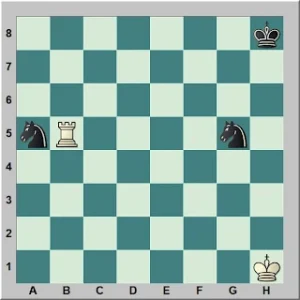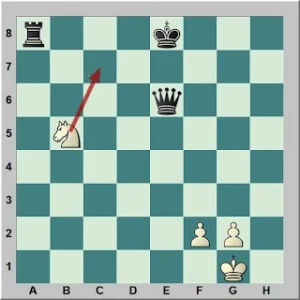Here we will discuss the middle part of the chess game. The middle game creates a board position that you’ve never seen before. You don’t know the position of the piece at the very beginning as in the initial state. So it is difficult to play by any restrictive rules. So in this situation, trust your judgment. The middle of the game is the trickiest to manage. How to play the chess middlegame is very difficult to describe there or easily. However, several fundamentals can be taught. Knowing the basics helps to manage the game in an unfamiliar situation. I will try to explain the most important points with examples below.
Type of middlegame planning:
In the language of chess, mid-game planning is generally divided into two parts: short-term tactics and long-term strategy. But sometimes short-term plans can be converted into long-term plans. It is very difficult to explain exactly what these things are. So I will try to explain with an example.
Short Term Plan:
First, we will talk about short-term planning. Short-term planning refers to the problems-possibilities-opportunities-advantages created by oneself or the opponent in every one or two moves. If you want to learn chess, you must learn tactics before learning anything else, because if you lose your piece, you are sure to lose the game. It is said that chess is 99% tactics, and this is true. Normal players usually win the game by capturing each other’s pieces very easily.
Unprotected piece:
For example, if you move one of your pieces to an unguarded square that your opponent has, the opponent can capture that piece on the next move and then have one more piece for the rest of the game. So it is better to avoid such mistakes. If your opponent gives you any chance to capture a piece for free then you capture it, you will have more pieces, and your chances of winning the rest of the game will increase. If you are new to chess game then you will find it quite difficult to keep track of all the pieces on the board. So before moving any of your pieces to an unprotected square, be careful that the opponent cannot capture the piece for free. Do not move a piece into an unprotected square unless necessary. So keep all the pieces connected. And if the opponent ever leaves a piece unprotected, find a way to capture that piece.
Profitable exchange:
It’s always good to be able to capture something for free. But as the opponent gets a little stronger, they won’t let you capture anything for free, so you have to learn other capture techniques. Try to capture the opponent’s high-value piece in exchange for your low-value piece. All in all, you will benefit from it. For example, if you can capture the opponent’s queen in exchange for a rook, then you gain, because the value of the queen is higher, because the value of the queen is 9, the value of the rook is 5.
For the same reason, it is profitable to capture another piece instead of a pawn, to replace a bishop or knight, or to capture a queen. It is even profitable to capture a queen instead of two bishops or a knight and a bishop. Because the sum of two bishops is 3 and 3 or 6, but the value of a queen is 9. Calculate the results of any such exchange. Try to make a profit, or try not to make a loss when it is not possible to make a profit.
Now I will teach you some more tricks to win points. It is often better to attack an unguarded piece to win the opponent’s piece for free or profitably, but the opponent will usually have time to counter the attack with proper defence in the next move and expose himself. So what is the way to win points? The answers are in the following section.
Fork:
Since attacking a weak target is less likely to succeed, consider attacking two targets at once instead of one. Yes, a two-pronged attack is much more effective than a one-pronged attack. Simple rules, right? Applying this rule to your own game is not so easy. In fact, behind all the hugely difficult moves in tricky positions, there is somehow a fork hidden somewhere. However, it is not always easy to find the target of the attack. So it takes practice. The more you practice, the easier it will be to find the target of the attack.
Below is a very simple example of how a fork works.

In the image above the white rook has attacked two black knights at once, black can move one piece to safety, but white can eat the other on the next move. So all in all Black will lose one knight.

Following the arrow in the top position, the white knight can attack the king and queen together. Another example

White’s knight in the top position can attack black’s king, queen and rook simultaneously with moves following the arrow. Attacking more than two big pieces with one knight in this way is called a family fork.
Notice that the knight on the white square can only move to the black square, and can only attack the white square. So it is not possible to attack simultaneously with knights if two pieces are on opposite colored squares. A very easy way to avoid the knight’s attack is to make sure that all the big pieces are in the same coloured room. Below are some more examples:

The white knight attacks the black king and rooks together. Black can, of course, capture the white knight with the queen, but this will result in a loss because the queen is too expensive. A knight costs 3, but a queen costs 9, and a rook costs 5, so capturing a knight with a queen instead of capturing a rook costs less (five instead of three).
Below is a slightly harder example.


